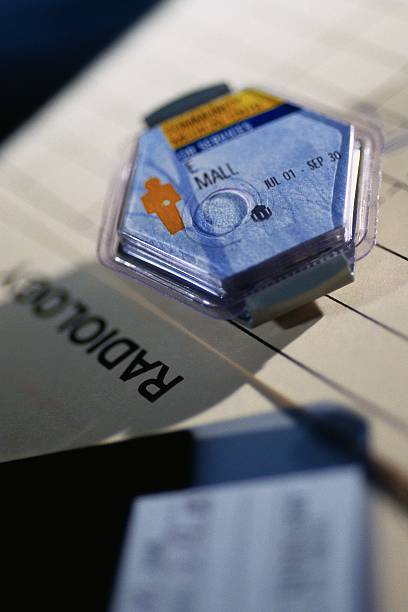Types of dosimeters
DOSIMETER
A radiation dosimeter is a device that measures exposure to ionizing radiation. It has two main uses: for human radiation protection and for measurement of dose in both medical and industrial processes.
Dosimeters are devices used to measure the amount of energy deposited by ionising radiation. This measurement is used to estimate the effective dose received by the human body through exposure to external ionising radiation.

Doses received following internal exposure from incorporation of radioactivity are not
assessed by these dosimeters but if necessary determined through other methods.
The different types of dosimeters are:
* Film badges
* Thermoluminescent dosimeters
* Electronic dosimeters
* MOSFET dosimeters
Film badge dosimeter:
The film badge dosimeter or film badge is a personal dosimeter used for monitoring
cumulative radiation dose due to ionizing radiation.
The badge consists of two parts:
* photographic film
* holder
The film emulsion is black and white photographic film with varying grain size to affect its
sensitivity to incident radiation.
Some film dosimeters have two emulsions, one for low-dose and the other for high-dose
measurements.
These two emulsions can be on separate film substrates or on either side of a single
substrate. After use, the film is removed from a packet that protects it from light
exposure and developed to measure exposure.
The film badge is used to measure and record radiation exposure due to gamma rays,
X-rays and beta particles.
When the film is irradiated, an image of the protective case is projected on the film.
Lower energy photons are attenuated preferentially by differing absorber materials.
This property is used in film dosimetry to identify the energy of radiation to which the
dosimeter was exposed.
Knowing the energy allows for accurate measurement of
radiation dose.
Though film dosimeters are still in use worldwide there has been a trend towards using
other dosimeter materials that are less energy dependent and can more accurately
assess radiation dose from a variety of radiation fields with higher accuracy.
Thermoluminescent dosimeter (TLD)
Thermoluminescent dosimeter measures ionizing radiation exposure by measuring the
ntensity of visible light emitted from a crystal in the detector when heated.
The intensity of light emitted is dependent upon the radiation exposure. Both the quartz fiber and film badge types are being superseded by the TLD and EPD.
A TLD measures ionizing radiation exposure by measuring the intensity of visible light emitted from a crystal in the detector when the crystal is heated
The intensity of light emitted is dependent upon the radiation exposure. Materials
exhibiting thermoluminescence in response to ionizing radiation include but are not
limited to calcium fluoride, Iithium fluoride, calcium sulfate, lithium borate, calcium
borate, potassium bromide and feldspar.
Electrenic personal dosimeter (EPD)
The electronic personal dosimeter (EPD) is an electronic device that has a number of
sophisticated functions, such as continual monitoring which allows alarm warnings at
preset levels and live readout of dose accumulated.
These are especially useful in high dose areas where residence time of the wearer is
limited due to dose constraints.
The dosimeter can be reset, usually after taking a reading for record purposes, and
thereby re-used multiple times.
MOSFET dosimeter
MOSFET dosimeters are now used as clinical dosimeters for radiotherapy radiation beams.
The
main advantages of MOSFET devices are:
1. The MOSFET dosimeter is direct reading with a very thin active area (less than 2 m).
2. The physical size of the MOSFET when packaged is less than 4 mm.
3. The post radiation signal is permanently stored and is dose rate independent.
* Gate oxide of MOSFET which is conventionally silicon dioxide is an active sensing material in MOSFET dosimeters.
* Radiation creates defects (acts like electron-hole pairs) in oxide, which in turn affects the threshold voltage of the MOSFET
This change in threshold voltage is proportional to radiation dose.
* Alternate high-k gate dielectrics like Hafnium dioxide and Aluminum oxides are also proposed as a radiation dosimeters.


Comments
Post a Comment